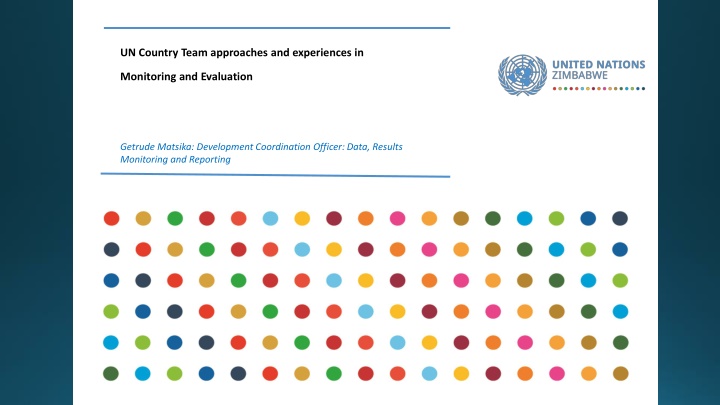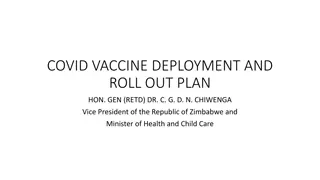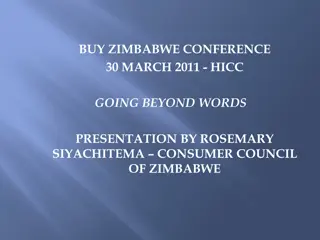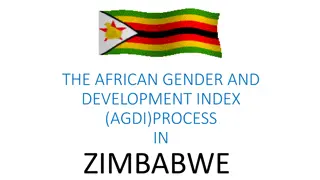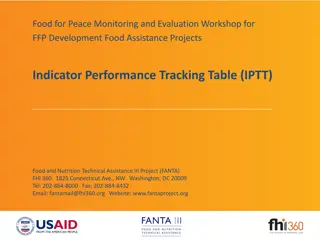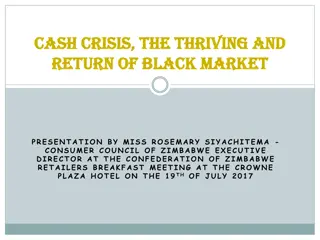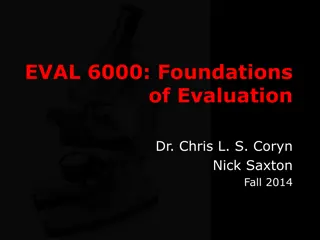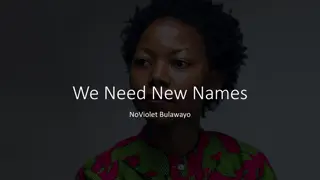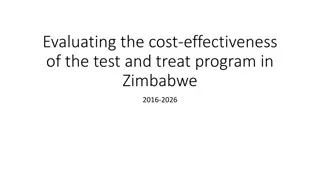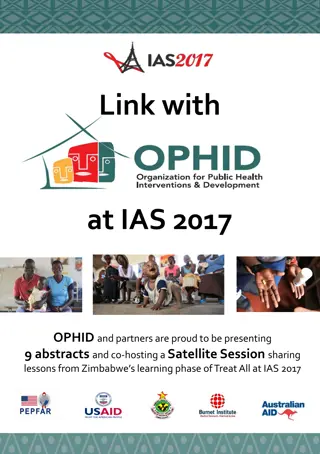UN Country Team Approaches in Monitoring and Evaluation in Zimbabwe
The UN Country Team in Zimbabwe is focused on supporting the government in delivering transformative change for all citizens. They aim to strengthen institutional capacities and empower communities to drive human development and productivity, ultimately leading to a better quality of life for all. The team follows a structured approach aligned with Agenda 2030 and the National Development Strategy 1, prioritizing people, planet, prosperity, and peace.
Download Presentation

Please find below an Image/Link to download the presentation.
The content on the website is provided AS IS for your information and personal use only. It may not be sold, licensed, or shared on other websites without obtaining consent from the author.If you encounter any issues during the download, it is possible that the publisher has removed the file from their server.
You are allowed to download the files provided on this website for personal or commercial use, subject to the condition that they are used lawfully. All files are the property of their respective owners.
The content on the website is provided AS IS for your information and personal use only. It may not be sold, licensed, or shared on other websites without obtaining consent from the author.
E N D
Presentation Transcript
UN Country Team approaches and experiences in Monitoring and Evaluation Getrude Matsika: Development Coordination Officer: Data, Results Monitoring and Reporting
Why are we here? To support the Government of Zimbabwe to deliver transformative change for all people in Zimbabwe.
THE UN, GOVERNMENT AND PARTNERS approach to delivering on the Agenda 2030 and NDS 1 Transformative change in the quality of people in Zimbabwe Enabling environment Empowerment If policies, institutional frameworks, regulatory frameworks and interventions are implemented and structural challenges are addressed Then human development and overall productivity is Then institutional, community & individual resilience is strengthened leading to transformative change in the quality of life of all people in Zimbabwe And If Government and partners capacities at national and sub-national levels are strengthened And if communities and vulnerable people are empowered to demand and meet their responsibilities increased ensuring employment, equitable distribution of income, wealth and productive assets such land, equitable access to quality services and protection of the environment Institutional capacities Human development and overall productivity
WHAT IS THE STRUCTURE OR MECHANISM FOR DELIVERING ON OUR PROMISE?
UNCT Delivering on Agenda 2030 and NDS 1 Priority 1: PEOPLE Priority 2: PLANET Environmental protection, climate resilience and natural resources management People-centred- inclusive, equitable human development and wellbeing Zimbabwe United Nations Sustainable Development Cooperation Framework (ZUNSDCF) 2022-2026 Aligned to the National Development Strategy 1 (2021-2025) Priorities Economic transformation, equitable, resilient and inclusive growth Transformative, accountable, equitable and inclusive governance Priority 4: PEACE Priority 3: PROSPERITY
UNCT Delivering on Agenda 2030 UNCT Delivering on Agenda 2030 and NDS 1 and NDS 1 PEOPLE PEOPLE SDGs 1 , 2, 3, 4,5 SDGs 1 , 2, 3, 4,5 PLANET PLANET PEACE 16 PEACE 16 Goals 6, 12, Goals 6, 12, 13,14, 15 13,14, 15 PROSPERITY PROSPERITY SDGs 7, 8,9,10,11 SDGs 7, 8,9,10,11
HOW DO WE PREPARE FOR IMPLEMENTATION, MONITORING AND EVALUATION?
What is happening and what do we learn? https://rockpaperscissorsinc.com/lets-learn-together-with-powerful-teaching- workshops/
Results Based Management Inclusivity: Meaningful participation throughout the process Designing solutions & prioritisation Context and Situation Analysis (to understand what is happening) Measuring and delivering results Evaluation, learning & adjusting What change is to happen? What is the current situation? How do we know that there is progress? How do we know change happened? What tools & capacities do we need? How do we implement, where, with whom?? With what capacities and resources? What is the issue? Political, economic, social and cultural Who is affected? Who is the worst affected? Where are they? Why? Root, underlying, immediate causes? How & in what ways? What is being done to solve the problem & by who? Use disaggregated data and evidence What therefore should be done? What is the big picture? What are the national, regional and global priorities? Who can do what? Who is being targeted? What are the risk factors? What are the assumptions? What change has happened? Who has changed? How? What is working well? What needs to be improved? Will this change last after the UN?
Monitoring results for LNOB PESRONS WITH DISABILITIES WOMEN AND GIRLS (RURAL AND URBAN) POPULATIONS HARDEST HIT BY DISASTERS AND CLIMATE SHOCKS YOUTHS & CHILDREN LNOB MIGRANTS AND REFUGEES, ASYLUM SEEKERS & STATELESS PERSONS OLDER PERSONS KEY POPULATIONS INDEGENOUS PEOPLE
The Results Chain Start here and work your way backwards what is the change you want to see? Inputs Activities Outputs Outcome Impact The institutional and behavioral changes in development conditions that occur between the completion of outputs and the achievement of goals. Positive and negative long-term effects on identifiable population groups produced by a development intervention, directly or indirectly, intended or unintended. These effects can be economic, socio- cultural, institutional, environmental, technological or of other types. The financial, human, material, technological and information resources used for development interventions Actions taken or work performed through which inputs, such as funds, technical assistance and other types of resources are mobilized to produce specific outputs The changes in skills and abilities, or the availability of new products and services that result from the completion of activities within a development intervention. They are the intended or achieved effects of an intervention s outputs, usually requiring the collective effort of partners. What all stakeholders invest in! Implementation What we do! RESULTS: The difference we make!
What are we aiming to achieve and measure? National and subnational institutions capacity strengthened to deliver services 1. Women and girls and those in the most vulnerable and marginalized communities, benefit from equitable and quality social services and protection Vulnerable and marginalized populations including women and girls are empowered to access services and participate Gender responsive legal and policy frameworks are in place and implemented National and subnational institutions capacity strengthened to sustainably manage and protect natural resources, the environment and promote climate change resiliency Vulnerable and marginalized communities including women, girls and adolescents are empowered to cope with climate change and build resilience 2.Vulnerable and marginalized, benefit from greater environmental stability and robust food systems in support of healthy lives and equitable, sustainable and resilient livelihoods. ZUNSDCF Expected Results Policies in place to transform agrifood systems and promote sustainable resource management 3. Most vulnerable and marginalized, benefit from more inclusive and sustainable economic growth with decent employment opportunities Key institutions strengthened to design and implement policies, laws and Programmes for inclusive and sustainable growth and development Vulnerable and marginalized women, girls, adolescent empowered for productive and decent work opportunities. Business environment is improved national and sub-national levels capacity is strengthened to discharge their mandate (human rights, rule of law, access to justice) Vulnerable and marginalized including women and girls are empowered to participate and claim their rights Gender responsive laws and policies designed and implemented 4. Most vulnerable and marginalized, benefit from more accountable institutions and systems for rule of law, human rights and access to justice.
Measurement Framework for Results Result Performance Indicators Baseline Targets Data Sources Collection Methods Frequency Responsibility Impact Outcome 1 Output 1.1. Output 1.2 Outcome 2 Output 2.1 Output 2.2
How do we know we are getting somewhere? SMART Results (outcomes and outputs Indicators (Qualitative and Quantitative) SDGs indicators ZUNSDCF indicators NDS 1 indicators Milestones Targets (Yearly, Annual) Baseline (starting line)
Reporting Performance Compare to own past performance Compare to standard (if one exists) Compare to others (only if similar) Compare to set targets
Telling the results story Outcome indicator: Prevalence of childhood stunting and undernourishment (SDG 2.1.1 and 2.2.1) Output indicator: Proportion of severe acute malnutrition children supplied with stunting packages. Childhood stunting: <17% by 2026 Childhood stunting 23.5% (MICS, 2019) How was the result delivered: (1) 1000 stunting packages delivered to 10 wards with high rates of SAM children. (2) USD5million used to purchase stunting packages
Tracking Inputs (2023)
Tracking Progress Tracking Progress of UN Activities of UN Activities (2023) (2023)
Effective reporting UN system Wide Results and focus on UNCT priorities Report on results and not processes and activities; Use indicators, baselines and targets. How do we report How do we report our our achievements? achievements? Data and evidence driven including disaggregated data People focused including disaggregation Effective Effective reporting: reporting: Key principles Key principles Partnerships and targeted audience primary audience is Government Link results to resources and demonstrate contribution to SDGs
WHERE DO WE REPORT AND STORE INFORMATION?
UN Info: One Stop Shop UN Info: One Stop Shop Advancing the 2030 Agenda and the pursuit Accountability of the SDGs ZUNSDCF Planning, Monitoring Transparency Coherence Reporting Coordination
Key Takeaways as the Journey for VLRs begin Key Takeaways as the Journey for VLRs begin Data and evidence Results beyond activities Voices of the people Deliver results Innovation Capacities Ensure availability of data (disaggregated data) and evidence to inform the design of programmes and policies Orient development interventions and process to deliver results. Demonstrate achievements and change beyond activities and processes. Ensure the voices of the concerned stakeholders are heard Shift from the business-as-usual approach to more relevant innovative approaches that make a change in the lives of all people. Build capacities for institutionalizing IRBM and the LNOB principle
THANK YOU! getrude.matsika@un.org +263773295870
